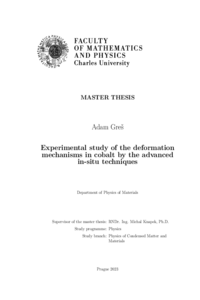Experimental study of the deformation mechanisms in cobalt by advanced in-situ techniques
Experimentální studium deformačních mechanizmů v kobaltu pokročilými in-situ metodami
diploma thesis (DEFENDED)

View/
Permanent link
http://hdl.handle.net/20.500.11956/185444Identifiers
Study Information System: 214094
Collections
- Kvalifikační práce [11407]
Author
Advisor
Consultant
Dobroň, Patrik
Minárik, Peter
Referee
Mathis, Kristián
Faculty / Institute
Faculty of Mathematics and Physics
Discipline
Physics of Condensed Matter and Materials
Department
Department of Physics of Materials
Date of defense
13. 9. 2023
Publisher
Univerzita Karlova, Matematicko-fyzikální fakultaLanguage
English
Grade
Excellent
Keywords (Czech)
kobalt|deformace|akustická emise|in-situ charakterizace|kolektivní pohyb dislokacíKeywords (English)
cobalt|deformation|acoustic emission|in-situ characterisation|collective dislocation motionVlastnosti čistého polykrystalického kobaltu během deformace v tlaku jsou ovlivněny přítomností vysokoteplotní fcc fáze. Za účelem prozkoumání tohoto vlivu byly připraveny vzorky žíháním na různých teplotách (600 řC-1100 řC) s ≈ 6-10% zbytkové fcc fáze. Další sady vzorků byly dále upraveny aplikací deseti nebo dvaceti tepelných cyklů s cílem stabilizovat mikrostrukturu a vytvořit ma- teriál bez fcc fáze. Vzorky byly deformačně testovány v tlaku a po odstranění fcc fáze pomocí teplotních cyklů byl pozorován pokles tažnosti a pevnosti. Ex- perimenty využívající přerušovanou deformaci ukazují, že transformace je během deformace pomalá a fcc zrna přispívají k deformaci hlavně svojí schopností měnit tvar. Přítomnost 71ř hranic napovídá, že transformace není úplně stabilní a další teplotní cykly by mohly vést k pokračování vývoje mikrostruktury. Pomalá trans- formace během deformace navíc neprodukuje detekovatelný signál akustické emise (AE). Energie událostí AE (detekované především kolem meze pružnosti) vykazují mocninné rozdělení pravděpodobnosti. Což odpovídá nedávným objevům kolek- tivního charakteru pohybu dislokací a lavinového chování skupin dislokací.
The behaviour of pure polycrystalline cobalt in compressive deformation is influenced by the presence of high temperature fcc phase. To investigate this influence samples are prepared using annealing at different temperatures (600 řC- 1100 řC) with ≈ 6-10% of residual fcc phase. Additional sets of samples are also subjected to thermal cycling around the phase transformation temperature for ten or twenty cycles with the goal of stabilising the microstructure and creating material with no fcc fraction. Samples are tested in compression and a decrease in ductility and strength is observed after the the fcc phase is removed using thermal cycling. The interrupted deformation experiment shows that the transformation is rather sluggish and the main contribution of fcc grains to deformation is their ability to accommodate shape change. The presence of 71ř boundaries also sug- gests that the transformation is not fully stabilised and further thermal cycling could lead to further evolution of microstructure. Additionally the slow transfor- mation does not seem to produce detectable acoustic emission (AE) signal. The energies of AE events (recorded mostly around the yield point) follow a power law distribution. This is in line with recent investigations of the collective nature of dislocation motion and the...
